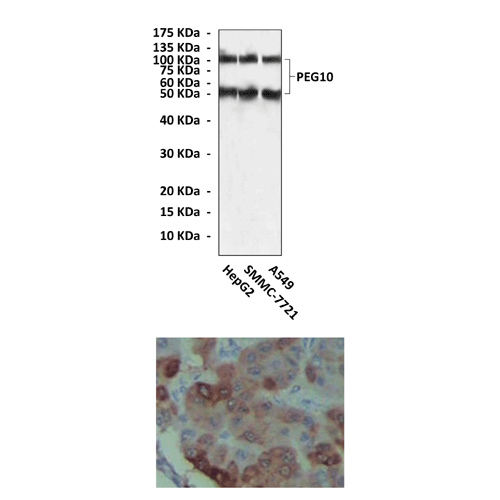Anti-PEG10: Mouse Paternally Expressed Gene-10 Antibody |
 |
BACKGROUND The Paternally Expressed Gene-10 (PEG10) gene was identified based on its location in an imprinted domain on human chromosome 7q21 and characterized as paternally expressed/maternally silenced. PEG10 is also imprinted in mice. The major open reading frame of PEG10 encodes a protein with distant homology to retroviral gag-pol proteins, suggesting that the gene arose from an ancient retroviral insertion event and then became fixed in mammalian evolution. Presumably related to its viral origin, the PEG10 mRNA encodes two protein isoforms (RF1 and RF2) via translational frameshifting. Recently, two groups have reported overexpression of PEG10 in hepatocellular carcinomas and in proliferating cells of regenerating normal liver and using cell transfections, both concluded that this gene has growth-promoting activity. PEG10 is also overexpressed in the embryonic form of biliary atresia, a disease associated with cell proliferation. Additional reports have suggested that PEG10 protein may act by blocking transforming growth factor beta (TGF-beta) signaling in epithelial cancers via binding to TGF-beta receptor II or by blocking the apoptotic factor SIAH1. It was recently found that specific chemokines induce PEG10 in normal B-lymphocytes and in B-cell leukemias, correlating with increased cellular resistance to apoptosis. However, the transcriptional pathways that activate this gene in proliferating cells have not been previously reported. The c-MYC transcription factor heterodimerizes with MAX and activates a large number of downstream target genes, many of which are essential for cell growth and proliferation. It was shown that c-MYC is an activator of PEG10 and showing recurrent acquisition of PEG10 protein expression in primary human breast and prostate cancers.1 Androgen activates PEG10 expression to promote carcinogenesis in hepatic cancer cells and also upregulates expression of human telomerase reverse transcriptase (hTERT) in HCC cell lines in a PEG10-dependent manner.2 In addition, the transcription factors E2F-1 and -4 were demonstrated to bind directly to the promoter of PEG10 and thereby regulate its expression.3 PEG10 plays a crucial role at the immediate early stage of adipocyte differentiation by induction of expressions of C/EBPbeta and C/EBPdelta.4
REFERENCES
1. Li, C-M. et al: Cancer Res. 66:665-71, 2006
2. Jie, X. et al: Oncogene 26:5741-51, 2007
3. Wang, C. et al: FEBS let. 582:2793-98, 2008
4. Hishida, T. et al: Anesthesiol. Clin. 581:4272-81, 2007
2. Jie, X. et al: Oncogene 26:5741-51, 2007
3. Wang, C. et al: FEBS let. 582:2793-98, 2008
4. Hishida, T. et al: Anesthesiol. Clin. 581:4272-81, 2007
Products are for research use only. They are not intended for human, animal, or diagnostic applications.
Параметры
Cat.No.: | CP10199 |
Antigen: | Purified recombinant human PEG10 fragments expressed in E. coli. |
Isotype: | Mouse IgG1 |
Species & predicted species cross- reactivity ( ): | Human |
Applications & Suggested starting dilutions:* | WB 1:1000 IP n/d IHC 1:200 ICC n/d FACS n/d |
Predicted Molecular Weight of protein: | 50 and 100 kDa |
Specificity/Sensitivity: | Detects endogenous PEG10 proteins including ORF1 (50 kDa) and ORF1-2 (100kDa) without cross-reactivity with other family members. |
Storage: | Store at -20°C, 4°C for frequent use. Avoid repeated freeze-thaw cycles. |
*Optimal working dilutions must be determined by end user.
Документы
Информация представлена исключительно в ознакомительных целях и ни при каких условиях не является публичной офертой








